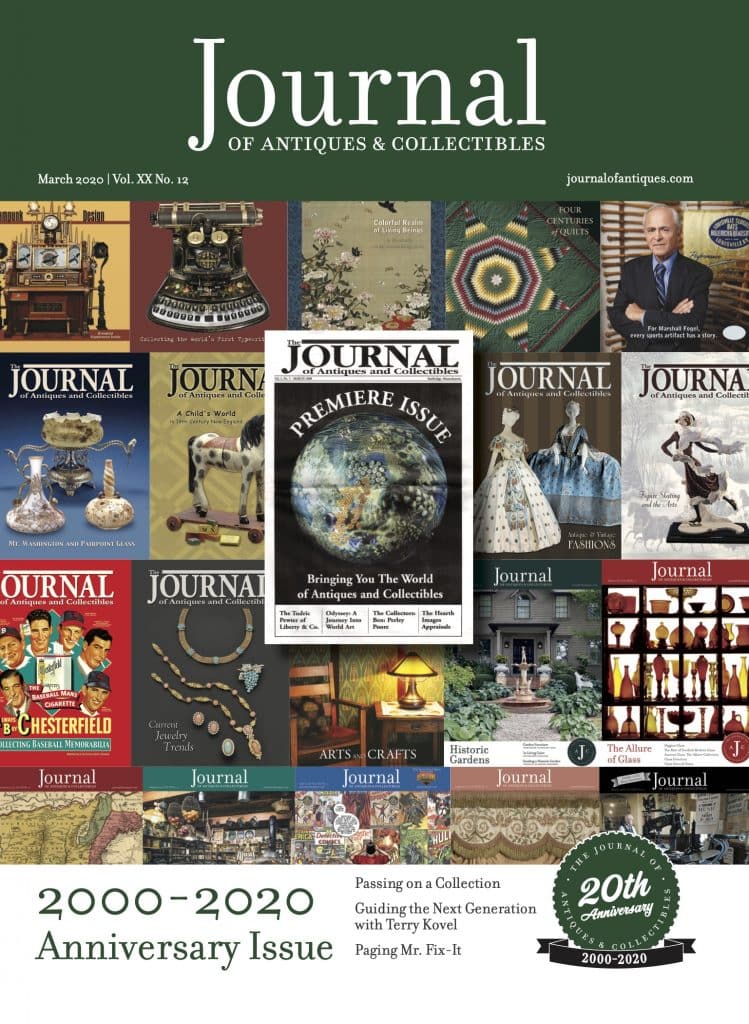By Maxine Carter-Lome
Celebrating 20 Years of Living and Loving Antiques
Anniversaries provide an opportunity for reflection, especially one marked by decades. In the last 20 years, the antiques market has seen “brown” go down; mid-century modern and folk art claim their space in the antiques community; a pop-culture shift in collecting; the rise of online buying and auctions; the vintage, salvage, and DIY movements inspiring a new generation of “antiquers;” makers coming to the forefront of the value story; the passing of business icons and friends; and values hitting unexpected lows and setting all-time records.
Although the “what” historically changes with the times, the “why” collectors collect remains unchanged: a personal, often nostalgic connection to the subject and an innate interest in history. At heart, we are life-long learners; passionate, enthusiastic, and knowledgeable about what we collect. We collect for fun, enjoying the thrill of the hunt and the camaraderie on the road; and to inform, preserve, and advance the history of our objects through the collections we build.
Antique collectibles are objects that by their very definition have a history and story that, as collectors, we look to unearth and share. We use old auction catalogs, books authored by fellow collectors, noted industry price guides such as Kovels’, knowledgeable dealers and appraisers, museum exhibitions, archival company records and catalogs, collector club websites, and provenance to explore an item’s past for identification, authentication, history, and value. Nothing adds interest and value in an antique object quite like a good backstory.
Much of our knowledge of the past is founded and advanced thanks to passionate collectors through the centuries who sought out, documented, and preserved the history of their subjects of interest by building highly-curated, object-based collections. Thomas Jefferson acquired the largest personal collection of books in the United States, twice seeding the Library of Congress. Charles Darwin spent five years traveling around the world collecting many different kinds of plants and animals, which helped him to develop his world-changing idea that successful animals adapt to suit their environment. At the end of his presidency, Theodore Roosevelt led an expedition to Africa outfitted by the Smithsonian Institution to collect specimens for the Smithsonian’s new Natural History Museum, now known as the National Museum of Natural History.
During the Victorian era, men, women, and children were passionate collectors of everything from butterflies to stamps, shells, stones, weapons, scrapbook ephemera, and even human bones. Some were motivated to collect in the name of science, while others filled their parlors with “curiosities” just for the fun of it. Today these collections are in the hands of museums, libraries, and next-generation collectors while some, sadly, were cherry-picked, discarded, or became flea market fodder. Like Darwin’s theory of natural selection, not everything survives the evolution of taste. This has many current collectors questioning, what will happen to their collection if their children or another family member is not interested? In the absence of a self-directed plan, what you would like to see happen most probably won’t. Hopefully, my article on page 24 inspires you to think about this now and prepare your collection accordingly.
If you think it’s easy for family members to take on your collection, to either sell off as their inheritance, preserve or donate, “think again,” say those of us who have found themselves in that situation. One such beneficiary of a legacy collection shares her journey and the emotional burden of liquidating her mother’s extensive collection of American sheet music in this month’s “Great Collections” column.
Also in this anniversary issue, Managing Editor Judy Gonyeau talks with Terry Kovel, whose annual price lists have been the go-to resource for dealers and collectors for over 50 years. Judy and Terry discuss what’s hot, what’s not, and why, on page 33.
A long-time writer for the Journal and collector, Donald Brian-Johnson uses the opportunity of this anniversary issue to share his encounters with collectors who question whether to have their items restored, repaired, or untouched.
While this issue explores and celebrates objects from our past as it does in every issue, it also calls our attention to the future. Collecting what we love can bring us great joy in the moment and our collections can also make an important historical contribution. As collectors, we have a responsibility to preserve and share what we know for the benefit of future generations.
Thank you for sharing these past 20 years with us. We are excited to continue our journey to see where it takes us!





Related posts: